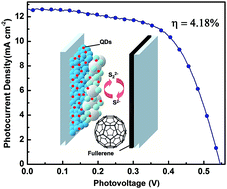Toward highly efficient CdS/CdSe quantum dot-sensitized solar cells incorporating a fullerene hybrid-nanostructure counter electrode on transparent conductive substrates†
Abstract
At present, the performance of quantum dot-sensitized solar cells (QDSCs) is still much lower than that of conventional dye-sensitized solar cells. Besides efforts on the development of photoanodes, a new generation of materials for counter electrodes is also urgently needed to optimize the structure of QDSCs and improve their power conversion efficiency (PCE). Here, fullerene (C60) films on transparent conductive substrates have been prepared through a cost-effective doctor blade process, which were subsequently applied as counter electrodes in QDSCs. Compared to conventional counter electrodes composed of Pt or activated carbon (AC) electrodes, the C60-based counter electrodes exhibit better electrocatalytic activity, lower charge-transfer resistance and higher exchange current density. Based on these merits, the QDSC with C60-based counter electrode and a polysulfide electrolyte shows an improved PCE of 4.18% under simulated 100 mW cm−2 AM 1.5 illumination. In contrast, the PCEs of the QDSC using Pt or activated carbon as counter electrode under the same conditions are only 1.17% and 3.48%, respectively. Stability test reveals that the C60-based counter electrode has good stability at room temperature.


 Please wait while we load your content...
Please wait while we load your content...